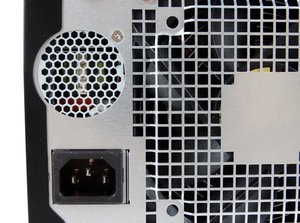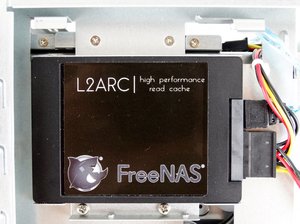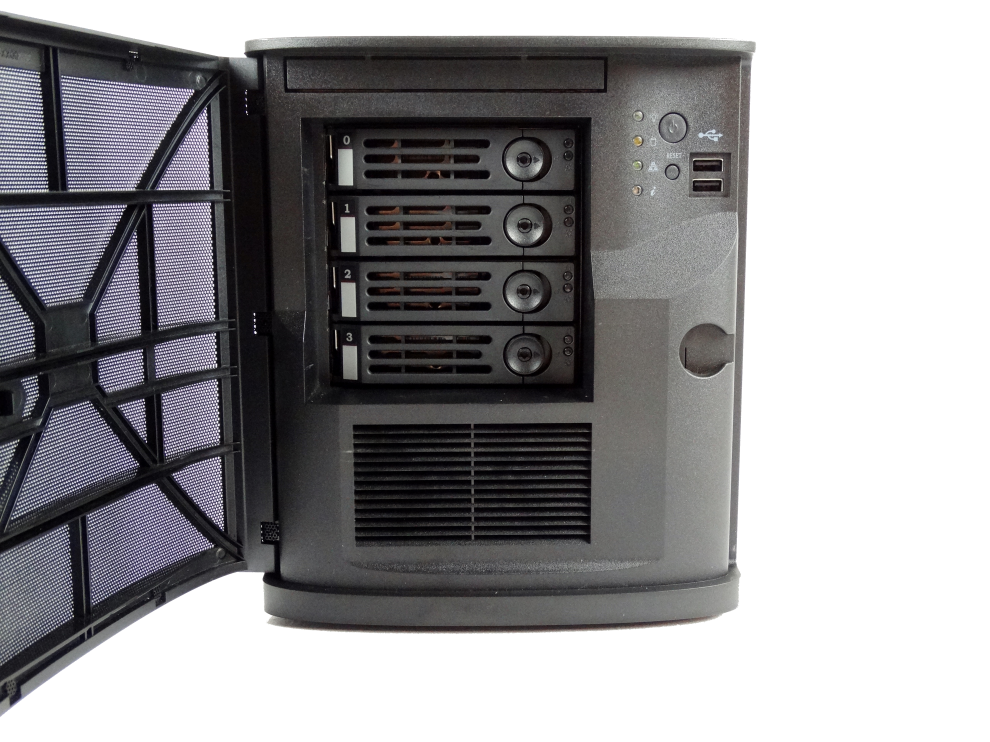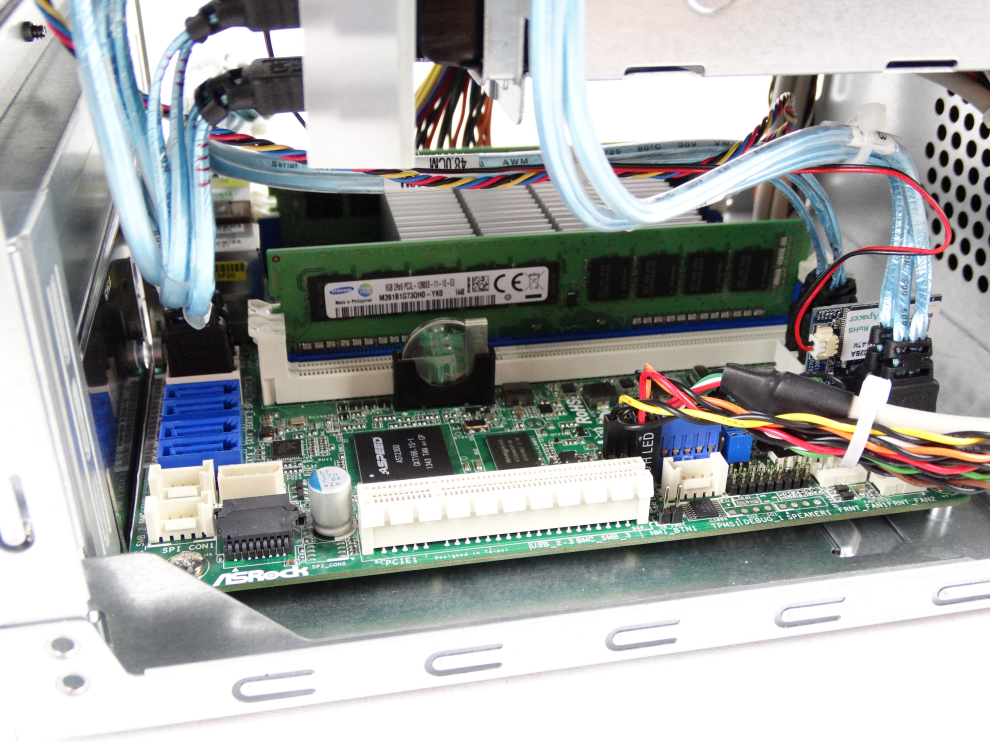iXsystems FreeNAS Mini NAS Review
iXsystems' FreeNAS Mini incorporates enterprise features, an advanced file system and a flash cache to deliver superior performance in its price range.
Why you can trust Tom's Hardware
A Closer Look


The FreeNAS Mini ships in two boxes. The first one serves as an outer shell, with the hard drives and accessories enclosed form-fitted foam. A second box holds the NAS in a foam shell so its edges are safely secured from corner drop damage.
The FreeNAS chassis is commercially available; you can purchase it as a standalone product like all of the components used to make this product. That makes upgrades and modifications easy, but would void the warranty.
The front of the case is mesh so air can pass through to cool the hard drives and inner system components. The FreeNAS Mini front cover has a lock to keep your drives secure. The power and reset buttons are also on the other side of the door for extra security.
The system has four status LEDs on the front next to the power and reset buttons. Two of the three USB 2.0 ports are also on the front. The system does not have a one-touch copy function though, a popular feature on many new NAS products that allows users to back-up storage devices with a physical button next to the USB ports.


Air passes over the hard drives and system components to keep them cool. On the bottom, four rubber feet isolate the platform from whatever surface the machine rests on. This keeps vibrations from transferring and amplifying to other objects.
The system ships with a large 140mm fan in the back to circulate air. Of course, larger fans can move air at lower RPM than smaller fans, which keeps noise to a minimum. In our testing, the FreeNAS Mini was very quiet.
The FreeNAS Mini uses two Intel gigabit Ethernet ports that can be configured independently or together as a team to increase bandwidth or reliability. A third gigabit Ethernet port allows administrators to log into the base system to configure BIOS options, check system status and use the console for out-of-band management.
Get Tom's Hardware's best news and in-depth reviews, straight to your inbox.


The system uses an internal power supply, so you don't have to find a hiding spot for a power brick. The PSU has dedicated cooling, though its small fan is located deep inside the case and not on the outer edge.
A Kensington lock mount on the side of the system not only gives you a way to physically secure it, but also acts as a lock for the chassis cover as well.
Our sample shipped with 16GB of DDR3 ECC RAM and two of its four slots populated.
On the other side of the system, we found a free PCIe 2.0 x8 slot. It's possible to add 10GbE to the system, but you need to find a 10GbE NIC with driver support and should consult iXsystems about warranty issues.


Our system also shipped with two FreeNAS-branded SSD drives. The ZIL SSD is for caching data writes and the L2ARC caches frequent reads. We'll be testing the NAS with and without cache. If you purchase the FreeNAS Mini without drives, you can still purchase iXsystem's ZIL and L2ARC SSDs on Amazon.
Current page: A Closer Look
Prev Page Pricing, Warranty And Accessories Next Page Sequential Data Transfer By Size
Chris Ramseyer was a senior contributing editor for Tom's Hardware. He tested and reviewed consumer storage.
-
Thanks for this review! I've been looking at this NAS for a while, ECC ram and ZFS where two strong points.Reply
-
DarkSable $1000 for a diskless system?Reply
How much is the case itself? That I might be interested in, but... -
hmarafi Thank you, a great review, if you can make a review how these devices can handle transcoding (Plex) Please.Reply -
colinstu Reply$1000 for a diskless system?
How much is the case itself? That I might be interested in, but...
The case is a Supermicro CSE-721TQ-250B which is $160.
A great motherboard would be the X10SDV-F which is $850 (dual GBe Intel nics, Xeon-D 8 core, check Anandtech they did a great review on it). Stronger CPU than the one in this review.
Then for $1017 you can get the X10SDV-TLN4F which includes built in 2x Intel 10GBe as well as 2x Intel GBe.
or for $?? (probably more) the X10SDV-8C-TLN4F which is the same as above but has Hyperthreading (16 threads). -
Lulzon Can someone explain what the market for these are? The form factor and limitations in expansion make it feel consumer level, but the power packed inside and price tag feel more enterprise for small teams or high workloads.Reply -
ammaross Replyutilizes the DRAM as a cache for in-flight data, you'll want to stick with ECC memory to protect that information from corruption.
Just by way of correction, ZFS has memory page checksums in addition to disk block checksums so even a memory bit corruption on non-ECC RAM can be healed on-the-fly. -
James Mason ReplyCan someone explain what the market for these are? The form factor and limitations in expansion make it feel consumer level, but the power packed inside and price tag feel more enterprise for small teams or high workloads.
Smaller businesses. I'm thinking law firms and architectural businesses, that just have a ton of documents and pictures to store. Which would fit right in at between 4-24tbs.
The price still seems kinda high, I'd like to see "real world use" as opposed to benchmarks but that's so difficult to actually do. -
BulkZerker All that processor for a nas... Asrock's avaton board still seems like a better choice IMO. Than again, I'm more looking at max storage vs max speed., esp considering how this nas can and will be set up.Reply -
photonboy Price is very reasonable for small business assuming someone with enough tech knowledge to setup properly.Reply
If the price seems high then it's not for you, but as said this is not a consumer product for home users. You want a basic, easy solution then investigate some of the WDMYCLOUD options instead. I bought a 4TB model and added a 4TB WD Elements as backup but that's for video storage and not as reliable nor as fast as a business class solution.
$2000 with drives for business is really not bad considering the cost to run a business, loss of data costs, and the fact you can probably write of some as a business expense. -
Mike Bethany FreeNAS with ZFS is a fantastic combination but the FreeNAS Mini needs one more drive for the RAID.Reply
On a side note, some guy vehemently argued against using ECC memory with ZFS. He admitted it was really stupid to *not* using ECC memory but he just couldn't admit he was wrong so he kept doubling down on dumb. His major argument? I was a few dollars off on the price of ECC memory.
You have to love the Internet.





